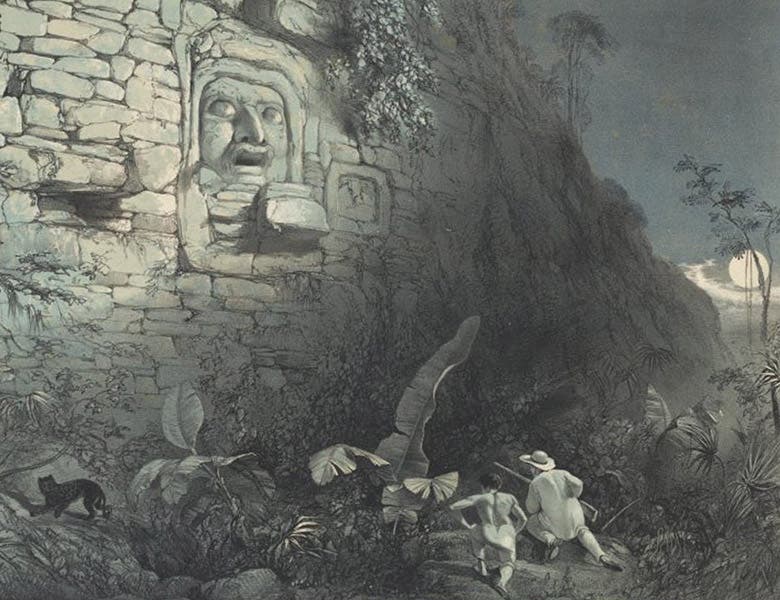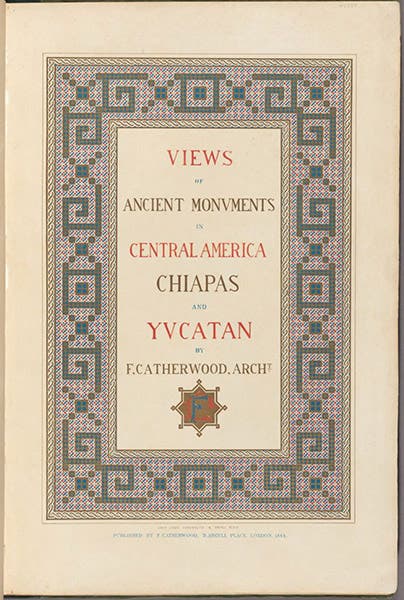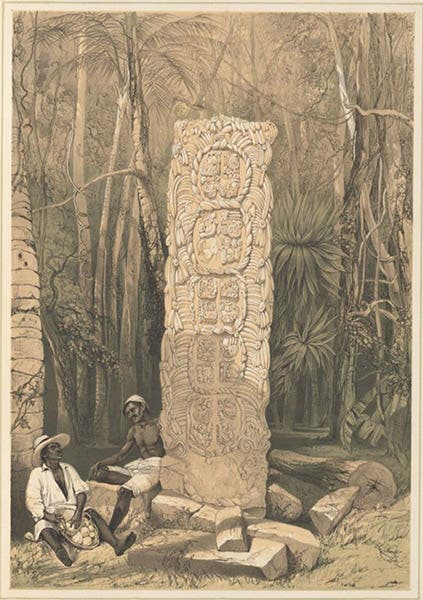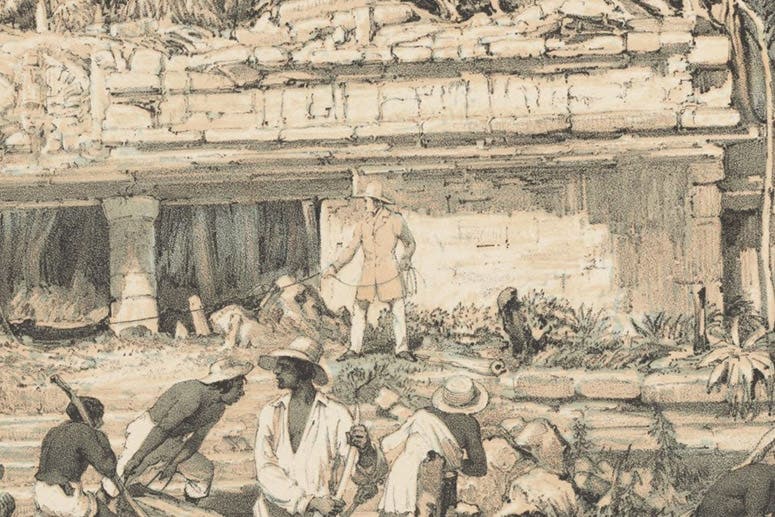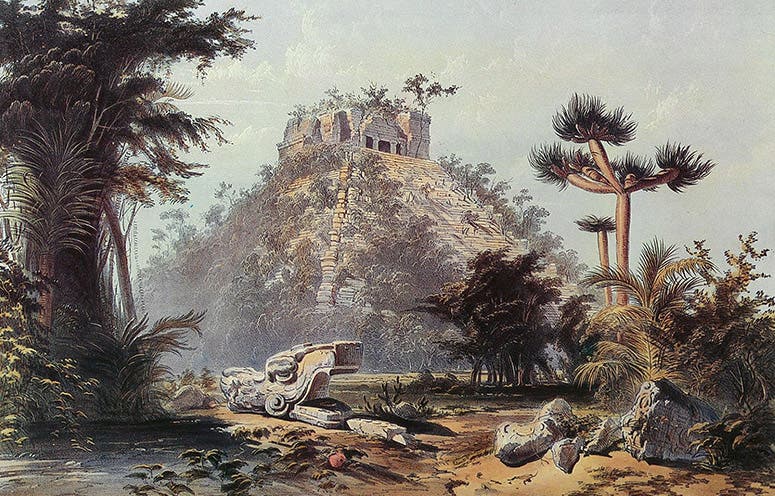Scientist of the Day - Frederick Catherwood
Frederick Catherwood, an English artist, architect, and traveler, was born Feb. 27, 1799. Not much is known about his first 22 years of life, except that he studied architecture and attended the Royal Academy in London, where he took a course with J.M.W. Turner, but in 1821, he made his first visit to Rome, and over the next seven years, he visited and sketched antiquities and buildings in Greece, Egypt, and the Holy Land; he then returned to Egypt and the Middle East for another 7 years. In 1836, back in London, he met an American traveler and writer, John Lloyd Stephens, and the two hit it off. Catherwood moved to New York, where he set up a Panorama – New York’s only Panorama – to display a painting he had made in Jerusalem. And he continued his friendship with Stephens. In 1838, an book dealer suggested to the two men that they organize an expedition to Central America to investigate the ruined Mayan cities that were being found in the jungle.
Since 1820, several explorers and travelers had come across Mayan temples and carvings at Copán in Honduras and Palenque in central Yucatan and, just recently at Uxmal in northeast Yucatan. These ruins were in most cases completely overgrown by jungle, and it was guessed that more were to be found. Stephens and Catherwood liked the idea of a joint exploration, and Stephens organized an expedition that departed in 1839. Catherwood was paid a salary to make drawings, which would be the property of Stephens. They visited Copán and Palenque, and then Uxmal, Kabah, Sabactsche, Labnah, and Bolonchen.
Most of these sites had not yet been cleared, and Stephens and Catherwood hired laborers and cleared them. Catherwood drew everything they encountered. Because Catherwood had seen all the ancient styles of architecture in the Mediterranean area, he knew immediately that Mayan architecture was unrelated to any old-world styles of building (Catherwood’s predecessors in exploring Central America generally thought the buildings were constructed by wayward Greeks, Egyptians, or one of the lost tribes of Israel). Since present day Mayans in the Yucatan did not build anything remotely resembling the ruins they had uncovered, Catherwood presumed they were built by ancient Mayans. The fact that the faces in many of the carvings resembled the modern inhabitants lent support for that supposition.
After they returned to New York, Stephens published Incidents of Travel in Central America, Chiapas and Yucatan (1841); he wrote the text, and the two-volume book was illustrated with a hundred small engravings based on Catherwood's drawings. The book was a best seller. The two men went back to Yucatan in 1842 and saw the ruins at Chichen Itza and Tuloom (our Tulum), which prompted a second two-volume book, Incidents of Travel in Yucatan (1843), again illustrated with Catherwood engravings. We do not have either of these travel narratives in our collections, but the Spencer Reference Library at the nearby Nelson-Atkins Museum has a 1st edition of the second book and a later edition of the first book.
Stephens and Catherwood then planned to enter the luxury book market, with a volume of large engravings of Mayan architecture that would rival John Jacob Audubon’s Birds of America. But the project fell apart, since they could not find publishers interested in such a project, nor sufficient subscribers. So Catherwood decided to carry on alone. Undaunted by the destruction of his Panorama (along with many of his drawings) in a fire, he moved back to London, hired lithographers, and published, in 1844, Views of Ancient Monuments in Central America (1844). This is a stunning volume. It has 25 folio sized lithographs of his favorite drawings of Mayan ruins, with short descriptions by Catherwood of each one. The edition was limited to 300 copies, of which 250 were stone-tinted, and 50 were hand-colored. Supposedly some 280 copies can be traced, so this is not a hard book to find, and copies sell quite regularly, but they also sell dearly. We do not have a copy of the 1844 edition in our Library, because it is out of scope. But since the work is so lovely, and has only 25 plates, many libraries have placed either selected prints or the entire work online. So we have borrowed several images from a copy that Harvard Library has placed online to illustrate this post.
Our first image shows a slight detail of a Colossal Head at Izamal by moonlight, a romantic print which is the last in the series of 25. We also display the Castillo at Tulum – here we show the entire plate, wide margins and all (third image) – and the back of an idol at Copán (fourth image). Plate 24 shows a temple at Tulum being cleared and measured; we do not show the entire plate (which you can see here), but rather a detail of one of the surveyors, since this is reputed to be a portrait of Catherwood – the only portrait we have of the elusive artist (fifth image).
In 1984, a beautiful facsimile set of the Views of Ancient Monuments was published in Mexico, based on photographs of hand-colored originals, with each print loose and stored in a portfolio. For some reason we do have a copy of this work, and although it is not the real thing, as an exemplar of the art of the facsimile, it is a stellar specimen, and we scanned several plates from that work and include them as well. These two plates show the Castillo at Chichen Itza (sixth image) and a broken idol at Copán (seventh image).
Catherwood died at the age of 55, while crossing the Atlantic in a deluxe paddlewheel steamship named the SS Arctic; it collided in the fog with a French ship and sank. It was somewhat of a scandalous affair, since nearly half of the crew survived, but not a single one of the women and children passengers; the death toll was over 300, including Catherwood. Nathaniel Currier issued a lithograph in 1854 commemorating the disaster (eighth image), and indirectly, the life and career of Frederick Catherwood.
William B. Ashworth, Jr., Consultant for the History of Science, Linda Hall Library and Associate Professor emeritus, Department of History, University of Missouri-Kansas City. Comments or corrections are welcome; please direct to ashworthw@umkc.edu.


